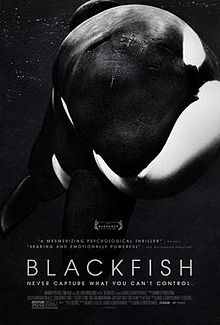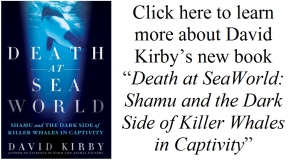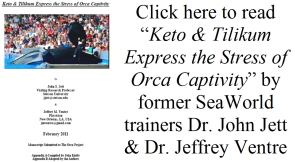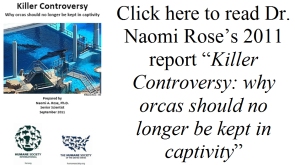Exclusive Interview #2: Former SeaWorld trainer Carol Ray talks orca safety & separation with T.O.P.
On August 23, 2010 CNN’s Brian Todd reported on the results of a government investigation into orca trainer Dawn Brancheaus’ death at SeaWorld in February. According to the Occupational Safety and Health Administration (OSHA), Tilikum had known aggressive tendencies, and SeaWorld was fined $75,000 for a willful safety violation for not recognizing hazards that could cause death. SeaWorld disagreed saying OSHA’s investigation shows a fundamental lack of understanding of whale safety. But former SeaWorld orca trainer Carol Ray believes the only way to keep a trainer safe is if they keep their distance and no longer go in the water. “I think that a trainer getting in the water with those whales is just a recipe for disaster” says Ray.
Today, Carol Ray joins The Orca Project for an Exclusive Interview to discuss orca trainer safety, her time at SeaWorld Orlando and her experiences of viewing wild orcas in the Pacific Northwest.
PREFACE: Carol Ray, MA CCP-SLP is a speech and language pathologist in Seattle. She worked at SeaWorld, Orlando, Florida from 1987 to 1990, performing alongside orcas such as Gudron and Kalina, also known as the original “Baby Shamu”, who died this past October. Now living and working in Washington State, Carol has been afforded the opportunity to view orcas in their natural habitat. In August, she appeared on CNN to discuss orca trainer safety… which can be seen here:

Click on the video to watch Carol Ray on CNN’s “SeaWorld Death Investigation” which aired August 23, 2010.
EXCLUSIVE INTERVIEW: Another former SeaWorld killer-whale trainer Carol Ray, MA CCP-SLP, talks about her time with the original baby Shamu, Kalina and other topics with The Orca Project (TOP):
TOP: Carol, thank you for stepping away from your busy schedule to speak with The Orca Project today. You’re the second former SeaWorld trainer that has come forth to shed light on the captive marine mammal industry.
After departing SeaWorld and earning a master’s degree, you moved to the Pacific Northwest, where you reside today. You’ve had multiple experiences viewing orcas in the Puget Sound area. Can you describe what it’s like to see orcas in the wild?
CR: I’m not sure I can adequately put it in words. It is an amazing and powerful experience to view them in the wild ~ frolicking, socializing and swimming free. I don’t think it matters how many times you see it, it’s always awe-inspiring. For me, there’s always a bit of sadness too, so it is bittersweet. It is a reminder to me. A reminder of whales I knew and loved, and the lives they’ve had to endure in captivity, and of what they have missed in no longer being free.
TOP: Like former SeaWorld trainer John Jett (who joined T.O.P. in an October interview), you’re one of a very small group that has had experiences with both captive and wild orcas. There are so many young people wishing to become killer whale trainers. In your opinion how might seeing orcas in the wild affect their desire to work with killer whales in captivity?
CR: It would be surprising to me if a young person could see these beautiful and intelligent mammals in the environment they are meant to be in, and then still want to work with them in captivity. I have to imagine that would take a lot of rationalizing. I find it more likely that a young person with a passion for these animals would be so impacted by the experience that they would no longer want to even see them in captivity, let alone train them to do tricks.
TOP: A recent New Zealand Surf Blog posted some amazing photographs of orcas body surfing some gigantic waves. Have you seen this article: “New Zealand orcas join surfers in search for the perfect wave”?
CR: Oh yes, the photos made me smile.
TOP: In the article, orca scientist Dr Ingrid Visser of Orca Research Trust, points out that New Zealand orcas eat a diet of sharks and rays. This differs from the salmon diet of the resident orcas, the herring diet of Icelandics, and the marine mammal diet of transients. All of these groups emit population specific vocalizations and behaviors unique to their culture; like body surfing or rock rubbing. In short, they live together for life. What impact might the mixing and matching of orcas amongst different theme parks have on the social structures at various parks? Could this possibly correlate with the social strife and aggressive behaviors that we’ve seen in captive populations?
CR: I believe that the manipulation of the social structure by marine parks can cause social strife as animals are constantly trying to “fit in” and establish their place in the hierarchy. The stress from being placed into an unnatural “pod” and the ensuing struggle for dominance could certainly contribute to the aggressive behaviors we’ve seen.
TOP: It is known at TOP that you were close to Kalina, the original “Baby Shamu”, who died unexpectedly in October. She was your primary waterwork animal. You’ve shared previously that upon learning that Kalina was being moved away and shipped to another Sea World facility in 1990, you objected. What was the reaction to your objection? Can you tell us a little bit more about that?
CR: Yes. While I was at SeaWorld Orlando, I worked most closely with Gudrun and Kalina. Kalina was an energetic girl, and a favorite for doing waterwork with. When we were told that Kalina would be moved out of Orlando I was really shocked. I was admittedly not an expert on killer whales in the wild, but I knew enough about their social structure and strong bonds to know that it was wrong to remove her at 4 years of age from her mother (and 2 half-sisters), and the only family she knew. I was so naive, it just never dawned on me that the purpose of breeding for SW was about repopulating their pools. I thought we had a responsibility to provide the whales with as much of a “normal” life as possible, despite being held in captivity. I felt like we were letting the whales down by disrupting their social group unnecessarily. Sounds silly, now, I know. In any event, it was something I was not able to keep quiet about. I raised my objections with a supervisor, individually, who told me to forget about it and said essentially that it would be nice to not have Kalina distracting the other whales and disrupting shows anymore. I then voiced my objections to managers in a meeting of all staff who were going to be working the night of Kalina’s removal. My concerns were dismissed without consideration, and were mocked. Additionally, after that meeting I was pulled aside and told that my original assignment for the night had been changed. Whereas I was originally assigned to be with Gudrun during the event, I was now assigned to take observations up on the catwalk. This was not an uncommon approach for management. That is, a trainer’s punishment for not “going with the flow” was typically removal from direct animal work.
TOP: Can you briefly describe what is involved with the transportation of an orca from one park to another?
CR: I can only imagine how traumatic it must be for the animals. Basically they are separated into a small/medical pool, a bunch of people jump in and corral them into a sling with holes for their pectoral flippers. They’re then lifted out of the water with a crane. Next they are placed in a killer whale coffin-sized box, put in a truck, then on a plane and the process is reversed at their destination. I realize my experience was some time ago but this is how it was and I imagine the basics must be the same. I always imagined they must feel such fear, being out of the water in a sling, hanging from a crane as well a the movements/sounds/sensory changes of trucks and planes. With Kalina, my recollection is that we attempted to separate her from the other girls and her mother in training sessions leading up to the actual departure date, so that she would separate more easily into the med pool. She was so unaccustomed to being separated, these were not easy sessions and we had to use nets to separate her.
TOP: You were re-assigned to making observations then? What did you witness after Kalina was removed?
CR: After Kalina was removed, I stayed and made observations throughout the night. This is one of the worst memories I have from my time there. Her mother, Katina, was not an overly vocal whale but that night I watched her for hours as she stayed floating in one spot, alone, emitting such heart-wrenching vocalizations it truly broke my heart. The other girls, including Katerina (Kalina’s sister, Katina’s other baby at that time) left her alone in her grief even though the gate between their pools was open. WATCH A NEWS REPORT ON KALINA’S TRANSFER BELOW:
TOP: Is it reasonable to speculate that separating and scrambling orcas between social groups increases the stress for all of the involved animals?
CR: Certainly it makes sense that it would. In addition to the stress of the actual move, there are the ramifications for the group left behind, as well as the introductions and the constant re-establishment of social order as groups change. I don’t believe killer whales have to do that sort of thing on a regular basis in the wild. I remember when Gudrun was moved from Holland to SWF in Nov 1987. Although I was working as a tour guide at that point, and had not yet transferred into the animal training department, her very loud distress vocalizations were heard all over the park for months, and it took quite a while to integrate her into the existing social group.
TOP: Carol, you began working for Sea World’s animal training department in December of 1987, just one month after John Sillick was crushed at SeaWorld San Diego. He suffered a broken pelvis, femur, and ribs, amongst other things, and remains crippled today. Were you given any information regarding this tragedy when you began working in the animal training department?
CR: This occurred when I was working as a tour guide. The information we were given in that department was that it was a “trainer mistake”. Naturally when I started working in the animal training department I expected more information, and asked. I was surprised to get the same response “trainer error, simple as that”…and nothing more. WATCH A VIDEO OF THE JOHN SILLICK INCIDENT BELOW:
TOP: Are you hopeful (or fearful) about the future of orcas and other marine mammals… particularly those in captivity?
CR: Parks like SeaWorld did a service in making us care about the ocean and these amazing creatures. That’s one reason why many trainers who are good people and now have doubts about captivity stay for so long… because they truly care about the well-being of these animals. It can feel like there is no way out. However, we now have technology like sophisticated high-definition underwater cameras and tracking devices that allow scientists and the rest of the world to see and learn about these creatures in the wild. As more parents become aware of the life these animals live in captivity, they will no longer see someone riding on Shamu’s nose as good family fun. We now have a generation of kids who have evolved. They do care about orcas and the planet and my belief is they think we can do better than marine mammal shows for human amusement.
TOP: Thank you very much Carol. We appreciate you talking with us today. That concludes our interview.
—————————————————————————–
You can read more from Carol Ray in a recent Orlando Sentinel story: “Former whale trainers criticize SeaWorld safety proposal”.
And don’t forget to check out these other exclusive former trainer interviews on The Orca Project:
Exclusive Interview #1: Former SeaWorld trainer John Jett PhD talks Tilikum with T.O.P.
For more information and exclusive content, visit Carol Ray’s page HERE at Voice of the Orcas, a new website created by four former SeaWorld trainers, sharing a common philosophy to provide a voice to those without.
And for a wealth of orca info, please visit Orca Tracker, a geospatial interactive map connecting orca events and scholars from around the world.
Update from The Orca Project: December 5, 2010 As Carol describes in the above interview, the separation of orcas from their families can be quite traumatic. OrcaHome reports that another orca family in Japan is about to face the same stressful situation:
Orca Home News reports: “28-year-old male Bingo and 24-year-old female Stella will be transferred from Kamogawa SeaWorld to Port of Nagoya Public Aquarium for breeding purposes, according to a news report in The Chunichi Shimbun. That would separate Stella from her three daughters Lovey, Lara and Ran 2. This will be a tough move, especially for 4-year-old Ran 2. The exact date of the transport is yet to be announced. At Nagoya, Bingo and Stella will be together with 28-year-old female Nami. It’ll be interesting to see whether the two adult females will get along.”
Note: Nami was recently transferred on June 19, 2010 to the Nagoya Public Aquarium from the Taiji Whale Museum where she has been since her capture in October, 1985. According to Cetacean Cousins, Nami’s trip took 23 hours by barge.
Update from The Orca Project: January 14th, 2011. It was reported today that Nami has died. She passed away after battling an unknown illness and had been feeling unwell on and off for a few months. At the Whale Museum in Taiji Japan, where she had been housed for most of her life after capture, she was kept in a natural seawater sea pen, and at the Port of Nagoya, her tank was artificially treated. We at The Orca Project believe with all these factors considered, it is what lead to her untimely death.
Trackbacks
- Elizabeth Batt | Former SeaWorld trainers challenge SeaWorld’s ads
- SeaWorld’s Proposed Multi-Million-Dollar Safety Gimmicks Don’t Measure Up | The Orca Project
- #Blackfish: A Plea for Outrage | Sirens and Musings
- Keto and Tilikum Express the Stress of Orca Captivity | Catharsiopa
- SeaWorld vs. OSHA- Killer Whale Showdown in Florida « The Orca Project
- Keto and Tilikum Express the Stress of Orca Captivity | Stop Cetacean Captivity
- SeaWorld Trainer Death Theory Debunked as a Ponytail Tale « The Orca Project
- The Truth about Lolita…? « The Orca Project
- Are Captive Orca Whales Displaying Emotional Behaviors Despite Scientific Evidence? Should they remain in captivity? | Without Me There Is No You
- SeaWorld’s Proposed Multi-Million-Dollar Safety Gimmicks Don’t Measure Up « The Orca Project
- Exclusive Interview: Former SeaWorld trainer John Jett PhD talks Tilikum with T.O.P. « The Orca Project
- Exclusive Interview #3: Former SeaWorld trainer Samantha Berg and the Perils of Orca Captivity (part 1) « The Orca Project
- Could "Spare Air" Save Marine Park Trainers During Orca Attacks? « The Orca Project
- Keto and Tilikum Express the Stress of Orca Captivity « The Orca Project
- Killer Whale Nami Dies Captivity « The Orca Project













Reblogged this on Analyzing World and commented:
Just one of reasons why orca captivity is wrong.
Have you ever started to do something, and then forgotten what it was.
When we know how to do this, we can actually remove it completely.
Still, you should discuss using herbs with your doctor first, especially if you are taking other medications.
Do you mind if I quote a couple of your articles as long
as I provide credit and sources back to your weblog?
My blog is in the very same area of interest as yours and my users would really benefit from a lot of the information you present
here. Please let me know if this ok with you. Appreciate it!
Heya! I know this is kind of off-topic but I needed to ask.
Does operating a well-established website like yours require a large amount of work?
I am completely new to writing a blog but I do write
in my diary every day. I’d like to start a blog so
I can share my experience and feelings online. Please let me know if you have any ideas or tips for brand new aspiring blog owners.
Appreciate it!
I really hope I will live to see this! Orcas do not belong captivity. They are such majestic beautiful creatures and deserve to be where they belong. I would probably lose it too, if I was held in a such small place to live.
This was a good read. I hope more will take the time read it. Hopefully people will start to understand that they dont belong in captivity anymore. This has to stop and I hope sometime soon it will. I think if more people knew about them and how they are in the wild they would feel ashamed for going to “parks” to see them in those little tanks.
I did too. I loved the animals and thought them amazing but was not aware of the horrendous abuses they suffered at the time.
Hi Carol,
Your interview with T.O.P. is so cool!! I live on Whidbey Island, WA, and only last summer I involved myself in the Orca world when I went to the Lolita 40-year tribute in Penn Cove, WA.
What you said about seeing the Orcas in the wild is exactly how I felt the first time I went to Friday Harbor, WA this last summer and saw them all at Lime Kiln – I will keep that memory forever.
I think in some ways the internet helps all wildlife by allowing people to see what animals are really like in the environments that they are meant to be in, rather than being forced to live in cages and tanks and to do tricks for people just for food – it’s so sad for me and I don’t even have the experience that you have.
Truthfully I haven’t been able to go to zoos, aquariums, pet stores, or especially circuses since I was about 16.
hi vickie – seeing the whales in the wild is so spectacular isn’t it! we’re lucky to live in these parts 🙂 so glad you made it to the Lolita anniversary tribute. I was out of town but hear it was really wonderful.
When humans learn that our fellow animal brethren are NOT here to entertain us and be held hostage and captive or to serve humans but learn that it is we who should serve and protect and help them, then I believe that we will have progressed mentally, emotionally, physically and spiritually to a level of more awareness of God’s purpose for all of us – to share and live in peace and harmony on this Earth. I pray for and await this moment when that comes to fruition, whether I be in my body or in my spiritual body – for all of Heaven shall rejoice!
I hope this happens in our lifetime!!!
That would be awesome!
thank you for sharing this with us. It’s always enlightening to be able to read/listen to another trainer’s perspective on this situation.